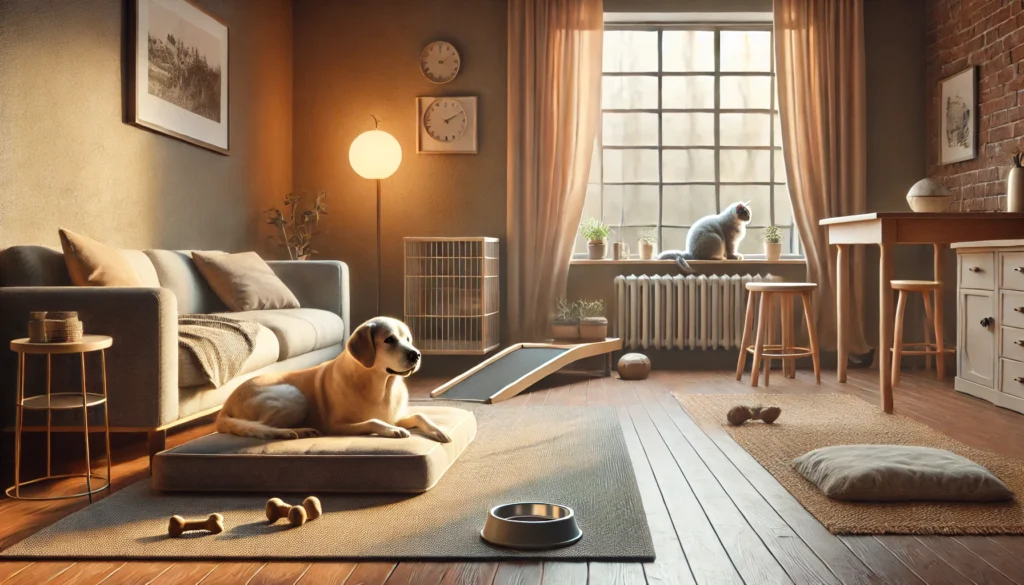As pets grow older, their needs change — but that doesn’t mean their days have to be boring. Senior dogs and cats still enjoy play, affection, and interaction. The key is adjusting activities and routines to suit their slower pace and changing energy levels.
If your older pet spends most of their time indoors, this guide will show you how to keep them mentally stimulated, physically comfortable, and emotionally fulfilled — all while respecting their age.
Understand the Needs of a Senior Pet
Before choosing any activities, it’s important to understand the basic characteristics of older dogs and cats:
- They may have less energy.
- They may experience joint pain or arthritis.
- Vision or hearing might decline.
- They need more rest but still enjoy interaction.
Knowing this helps you create a routine that is gentle, engaging, and aligned with their physical ability.
Provide Comfortable Rest Areas
Older pets sleep more — and their comfort matters.
- Use orthopedic pet beds to support joints.
- Keep bedding in quiet, draft-free areas.
- Place beds where your pet can still feel part of the family.
If your pet has difficulty climbing, consider low-entry beds or placing ramps near furniture.
Encourage Gentle Indoor Play
Just because your pet is aging doesn’t mean playtime is over. Adapted games are still fun and stimulating.
For Senior Dogs:
- Soft tug-of-war with plush toys.
- Short indoor fetch using lightweight balls.
- Scent games like finding hidden treats in boxes or towels.
For Senior Cats:
- Feather wand games (slow movements only).
- Crinkle toys and light batting games.
- Catnip toys in moderation.
Keep sessions short—around 5 to 10 minutes—to avoid overexertion.
Offer Low-Impact Physical Activity
Exercise helps keep joints flexible and weight in check, even in older pets.
- For dogs: short walks around the house, walking in circles inside, or walking up and down soft ramps.
- For cats: encourage climbing on low furniture or placing treats on steps for gentle activity.
Avoid slippery floors. Use rugs or mats to provide traction and prevent injuries.
Use Puzzle Toys for Mental Stimulation
Mental exercise can be just as tiring (and rewarding) as physical movement.
- Choose easy-to-solve treat dispensers or snuffle mats.
- Hide treats in egg cartons or folded towels for pets to uncover.
- Rotate toys to keep things fresh and interesting.
For senior pets with vision loss, rely more on scent-based puzzles than visual ones.
Stick to a Predictable Routine
Older pets appreciate consistency. It reduces stress and helps them feel secure.
- Feed, walk, and play around the same times each day.
- Avoid rearranging furniture or bowls frequently.
- Keep noise levels low, especially during naps.
Familiarity is calming for aging pets who may become confused or anxious more easily.
Provide Gentle Grooming and Touch
Physical contact reassures your pet and helps you monitor their health.
- Use a soft-bristle brush for daily grooming.
- Massage sore muscles gently.
- Speak in a calm, soothing tone during grooming sessions.
Many senior pets find grooming relaxing and even therapeutic.
Adjust Their Environment for Accessibility
Small home modifications can make life easier for your aging companion:
- Use pet stairs or ramps for couches or beds.
- Elevate food and water bowls to reduce neck strain.
- Ensure litter boxes have low sides for easy entry (for cats).
- Keep their necessities within close reach.
Remove any obstacles that could cause tripping or slipping.
Spend Quiet Time Together
Sometimes the best enrichment is just being present.
- Sit next to your pet during rest time.
- Talk softly, offer a gentle pat, or just share the same space.
- Watch TV together or listen to soft music.
This reinforces your bond and makes your pet feel loved, even without active play.
Keep Their Mind Engaged
Simple training can still be part of a senior pet’s life.
- Reinforce old commands like “sit” or “stay.”
- Introduce new, gentle ones like “touch” or “look.”
- Reward with small, soft treats or verbal praise.
Mental engagement delays cognitive decline and keeps your pet sharp.
Love and Patience Make All the Difference
Senior pets may not be as energetic as they once were, but their emotional needs never fade. What they truly crave is your time, understanding, and care.
By creating a peaceful, stimulating indoor environment tailored to their age, you can help your older dog or cat enjoy every moment to the fullest.
Their golden years should be filled with comfort, play, and love — and you have the power to make that happen every day.






